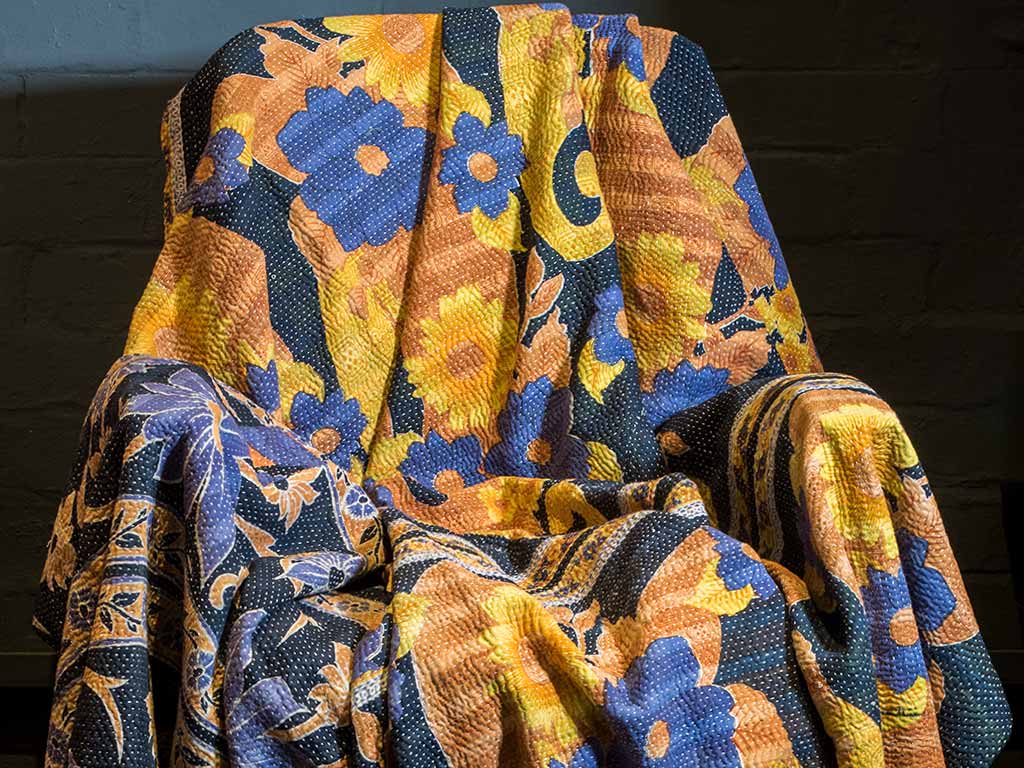What is Kantha?
Kantha is the embroidery stitch traditional to Bengal that is used to hold layers of fabric in a quilt. Kantha is also the name for quilt itself. The stitch is basically a simple running stitch that can be in straight lines or a complex and intricate pattern that gives an extra dimension of pattern in addition to the printed or woven designs in the fabric.
A pattern of squares of kantha stitching on a quilt.

Where did Kantha originate?
The origins of kantha seem to go back about 500 years to legends concerning a poet in an area of what is now a part of West Bengal in eastern India. It is said that the poet received a special piece of cloth from his mother which he called a kantha. Leaving aside this piece of legend we would say that kantha stitching originates in predominantly Bangladesh and Indian West Bengal. The popularity of the kantha stitch means it is now used as a decorative device in many parts of India.
Bold patterns are typical of kantha quilts, shown here on a sofa.

Nothing can afford to be wasted in India. A longstanding tradition among the village women of Bengal has been to reuse old cotton saris to make soft wraps and quilts for their babies. It’s not just a practicality; old fabric contains its own stories and memories. Made into a kantha, the sari fabric a woman wore next to her body for many years has a new life as shawl or blanket that protects her baby. The fabric itself contains history, memories, and can be seen as symbolic of survival and continuity. Seen in this context fabric can become more valuable over time as it gets passed down, given as family gifts at marriage ceremonies and the birth of a new child.
A soft colourful kantha throw.

Layers of fabric are layered neatly on the ground and ironed. Several loose running stitches are applied to hold the layers in place and then the cloth can be gathered up and worked at while being hand held. Women of all economic classes would make kanthas and the embroidery is usually done in the early evening once other work is finished. It's often a social occasion, sitting outside chatting and sewing. Saris are only a metre wide so larger kanthas are usually a kind of patchwork; damaged parts of the cloth are often repaired with small patches.
Large Kantha quilt on a futon sofa bed.

There are different ways to make kanthas and they were not just made as baby blankets. If only three of four layers are used and the stitching is loose the quilt will be soft and flexible. If more layers are used and the stitching is tighter, with shorter stitches closer together, the quilt will feel more substantial, less flexible. More robust pieces are made to cover a mattress, a seat or even the floor. When the stitches are short and very close they can be pulled shorter on one side than the other - this gives rise to the rippled effect that you may see on older kanthas. The ripples have the effect of trapping more air and making the quilt warmer.
Tight kantha stitching gives rise a rippled effect which increases warmth.

The border between India and only dates from the Partition of India in 1947 (when what is now Bangladesh was known as East Pakistan) so some similar cultural traditions such as kantha can be found in both West Bengal and Bangladesh. Of course there are also major cultural differences because Bangladesh is predominantly Muslim and West Bengal is predominantly Hindu. One difference in stitching styles is that the Muslim tradition uses geometric patterns as opposed to representations of organic life forms.
This kantha throw must have been a dramatic sari with a modern style.

At The Silk Road we describe the thinner kanthas as throws and the thicker ones as quilts. The throws are made in Rajasthan and the quilts in Bangladesh. Both types can be used to cover a sofa, chair or bed. The throws also make a great soft wrap - like a baby blanket for grown ups! We also sell kantha scarves and shawls that use two pieces of art silk bound with kantha stitching, either in straight lines or circular patterns.
This kantha throw has two wonderful sides, hard to say which is the best.


The quilts, throws, scarves and shawls all have one thing in common – each one is a unique work of art, in fact a reversible work of art since one side is always different to the other. You really do get two for one. But the real delight is the wonder of the patterns and colour combinations. Looking through a new batch when it arrives is one of the pleasures of working at the Silk Road! Looking through the fabrics is like looking at a spectacular directory of 20th century Indian fabric design. Some of the simple scarves contain wonderful fabrics and can also make excellent £25 wallhangings!
Reversible kantha scarves give a beautiful flash of vibrant colour.

By now you probably don't need any ideas as to how to use these beautiful kanthas but let's just say that they work equally well in a boho style bedroom and as a dramatic accent piece in a minimalist white room. You can also take them outside as a picnic blanket or to wrap yourself up on those cool nights at a festival. Kanthas are a great way to introduce some unique colour and sense of the exotic - and to make you smile each time you look at them!
Wow! An unusual and unique kantha quilt for a small sofa.

Check out our current selection of Kantha quilts and throws.
